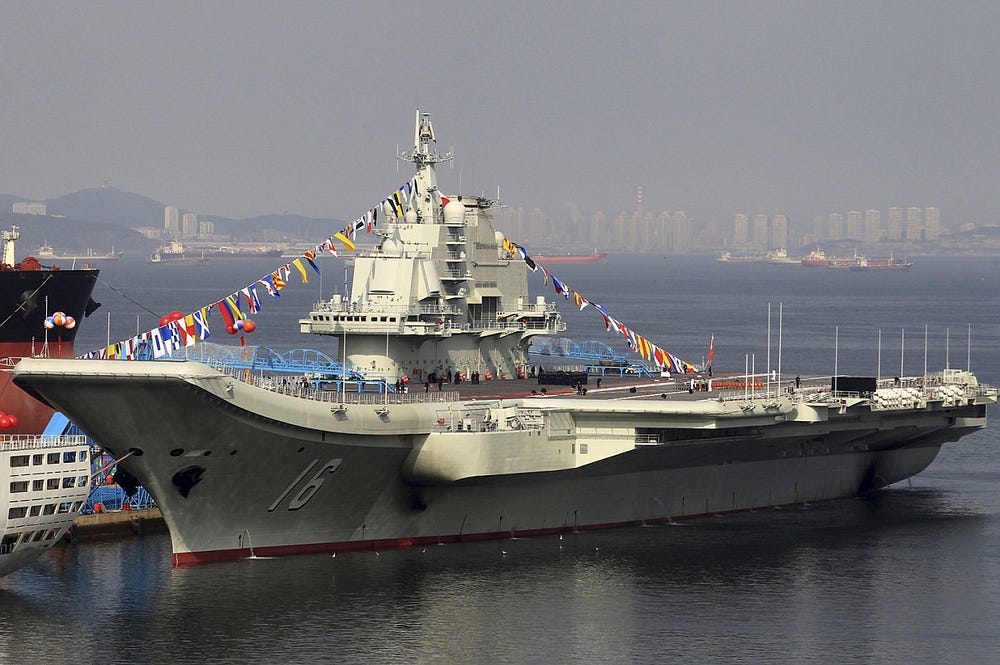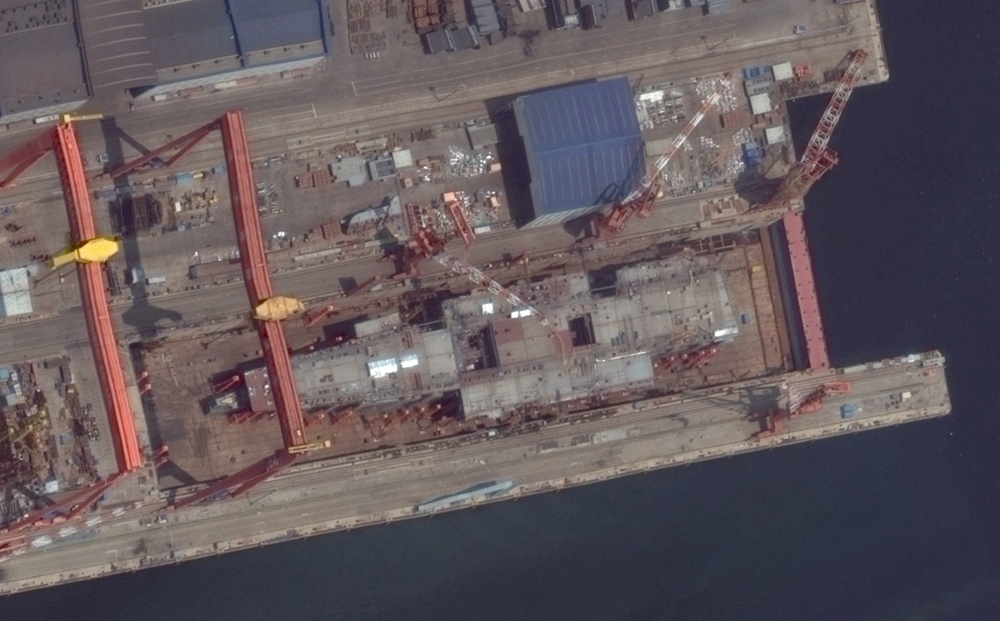
Posted on 11/06/2016 4:09:57 AM PST by sukhoi-30mki
Slowly but surely, China’s first indigenous carrier is coming into being. Laid down in 2015 with an expected launch date in 2017 or 2018, China’s second aircraft carrier may enter full service sometime around 2020.
The lack of transparency around the project has spurred a tremendous degree of speculation, down to some very basic questions. As was the case with Liaoning, China’s first carrier, analysts have a name problem — no one is quite sure what to call the new ship.
For years as Liaoning underwent construction and refit, China-watchers guessed as to the correct name, generally settling on the accurate but inelegant “ex-Varyag” (other guesses included Shi Lang and Zheng He).
While some have suggested “Shandong,” most commentators have settled around “CV-17.”
So, what do we know about CV-17?
Design
Photos of CV-17, under construction at Dalian Shipbuilding, suggest that she will strongly resemble China’s first carrier. She appears to be of roughly similar size to Liaoning, has a ski-jump, and apparently will have conventional propulsion.
Speculating on the basis of the appearance of a few models in the public domain, Andrew Erickson suggests that CV-17 may use gas or diesel/gas turbines. Reports on Liaoning’s propulsion system remain mixed and uncertain, but many suspect she uses Soviet-style steam turbines.
In a sense, CV-17 will become the second half-sister of the Russian Admiral Kuznetsov, which recently passed through the English Channel to great fanfare. We can expect that the Chinese will improve upon this design at the margins, but the core of the ship remains very similar to the vessel that emerged from the Soviet Black Sea Shipyard in 1990.
While this seems like a long time to stick with a single design, the U.S. Navy built Nimitz-class carriers to the same basic template for about 40 years.

The Chinese carrier ‘Liaoning.’ Photo via Wikimedia
Construction
CV-17 is, by far, the largest military vessel ever constructed in a Chinese shipyard. The number of shipyards worldwide that can handle construction of an aircraft carrier is remarkably small, and the workforce expertise needed to build the ship disappears quickly.
In a sense, CV-17 is as useful for industrial purposes as she will be for the military. The experience gained in her construction will set the table for the next Chinese carriers, which may have a more modern, effective design.
In particular, Chinese shipbuilders need to overcome several hurdles before they begin constructing first rate carriers.
They need to either develop effective models of nuclear propulsion for surface ships, or scale up existing conventional powerplants, as Chinese engine manufacturing has struggled with reliability. They need to decide whether to install steam catapults — an exceedingly complex process — or jump straight to electro-magnetic.
Some reports suggest that CV-17 may have catapults in addition to a ski-jump, which would make sense primarily from an industrial-capability point of view.

A J-15 fighter on ‘Liaoning.’ Photo via Wikimedia
Employment
In all likelihood, CV-17 will carrier Shenyang J-15 fighters — a variant of the J-11, itself part of the larger Su-27 “Flanker” family of aircraft. CV-17 may someday carry the J-31 stealth fighter, but at this point the future air wing is entirely notional.
Like her half-sisters, CV-17 will lack the capacity to launch large early-warning aircraft, making her dependent upon land-based aircraft and other types of sensors for a full picture of the battlespace.
This suggests that while CV-17 may venture farther afield than her half-sister Liaoning, she will not form the core of an expeditionary battlegroup. Her aircraft will lack the range, payload, and command and control tools necessary to undertaking independent expeditionary operations.
She, like Admiral Kuznetsov, will in overall capabilities more resemble one of the U.S. Navy’s America-class light carriers than a Nimitz or Ford-class supercarrier.
Most China watchers seem to believe that the PLAN will move on to a larger, more advanced design after CV-17. Innovations may include many of the systems taken for granted on American carriers, such as catapults (steam or electro-magnetic) and nuclear propulsion.
If so, this suggests that CV-17 is a stepping stone, enabling the Chinese shipbuilding industry to gain experience with larger vessels in the same way that CV-16 gave the PLAN the chance to develop rudimentary carrier flight skills.
But what will then happen to CV-17, after the PLAN moves on to larger ships? Unless the PLAN decides on a path similar to that of India — three carriers of wildly different specifications and capabilities — the next class will likely represent the core of China’s carrier force.
CV-17 will be paired with the comparatively ancient CV-16, conducting second-tier operations. Eventually, as Liaoning begins to feel her age (and unique construction history), CV-17 may shift into a training role.
With that in mind, the construction of CV-17 remains a watershed moment for China’s maritime aspirations. She will open the door to larger, better ships, and (with Liaoning) will accelerate the development of China’s corps of naval aviators.
And we all look forward to the day on which China gives this carrier a name.

CV-17 under construction in Dalian in June 2016. DigitalGlobe photo via Google Earth
In particular, Chinese shipbuilders need to overcome several hurdles before they begin constructing first rate carriers...
They’re gonna buy blueprints from the clintons?
The equipment hoist cross beams look funny in this picture. Spherical aberration or just pixel abnormality. Although the shadow for the right one looks the same. Looks like a funny slight “V” shape design...
You mean the Philippines, maybe?
:D
Those cranes do look strange .
Let us thank the clintons
I think that looks strange because it is taken (I believe) from a satellite?
There is absolutely no distraction due to the perspective of the photo-taker.
I believe the photo is legit.
Then again, I have absolutely zero background to base that view on. So take it for what it is worth.
:D
1st Chinese carrier Liaoning beside USS America, here referred to as a "light carrier":.jpg)

It should be noted that the USS America is not smaller version of a US fleet aircraft carrier design but rather an redesigned LHA without a well deck. It is aviation dedicated amphibious assault ship capable of operating helicopters and STOVL aircraft (AV-8B and F-35B) only. There is no arresting gear or catapult/ski ramp to support CTOL aircraft operations. While a large ship at 40K+ tons displacement, it is still is about 40K tons lighter in displacement than a standard US fleet aircraft carrier.
Comments about the propulsion systems of the CV 17 and subsequent PLAN carrier designs are quite interesting. The CV 16 is the ex-Varyag and the CV 17 is being reported as a Chinese refinement of that Soviet-era design. Soviet/Russian naval engineering is weak in large surface combatant propulsion plant design. The only nuclear powered large surface combatant ever built by the Soviets was the Kirov class battle cruiser. The Kirovs were few in number and did not have a good operational record. The Chinese do not have a proven Soviet design to draw upon for a starting point. Since the program risk of building a large displacement aircraft carrier with a new and unproven nuclear power plant design is probably very high, the Chinese might built a Kirov type large surface combatant in part to develop a reliable large nuclear plant design.
 ping
ping
Right, and I've never before seen such US amphibious assault ships referred to as "light carriers".
First, they're not "light" and second, not "carriers", but still, the comparison could be apt.
The Chinese Liaoning carrier is somewhat longer & heavier than USS America, may carry more aircraft, but likely is not more capable.
Regardless, USS America is not intended to fight other carriers.
That job is left to Nimitz & Ford classes.

Chinese short range nuclear missiles made air carriers obsolete in the Pacific theatre.
Read Pacific 2020 by RAND corporation.
Disclaimer: Opinions posted on Free Republic are those of the individual posters and do not necessarily represent the opinion of Free Republic or its management. All materials posted herein are protected by copyright law and the exemption for fair use of copyrighted works.